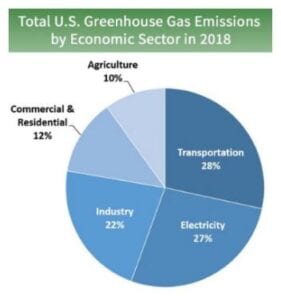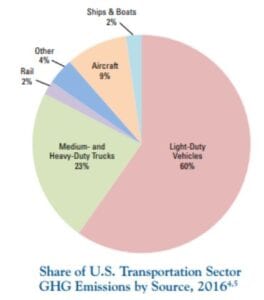How can we reduce emissions across ALL forms of transportation?
The United States comes second only to China as the world’s largest producer of carbon emissions, with transportation generating the most emissions of any economic sector: nearly 30 percent of the total. The consequences of CO2 pollution are well documented, but the technologies needed to combat the single greatest source of emissions in the U.S. aren’t just a fantasy. They’re real, commercially viable, and ready to be deployed at scale.
Much of the conversation around reducing transportation sector carbon emissions has centered on consumer adoption of electric vehicles (EVs). This has driven a great deal of government investment, from collaborations with industry researchers to the creation of tax credits and other incentives designed to lower the up-front costs of plug-in EVs. As a result, U.S. EV sales saw a remarkable 81% YoY increase in 2018, and 34% of Americans now expect to purchase one within the next decade.
However, transportation is much more than consumer vehicles. Related categories like commercial trucking (23% of transportation sector emissions), aviation (9%), ships and boats (2%), rail (2%), and others (4%) also emit large amounts of carbon. Consumer vehicles make a profound impact on the environment. However, even if every personal vehicle in America were electric-powered, transportation emissions would still be a serious problem. To fully curb transportation emissions, we must look beyond electricity toward renewable solutions like hydrogen fuel cells, which can be used alongside other renewables like solar energy and biofuels to meet the world’s transportation needs at a lower cost than fossil fuels.
Like traditional batteries, fuel cells use energy produced by a chemical reaction to generate electricity — but, like our passenger vehicles, they continue to operate for as long as they have fuel in the tank. Hydrogen is the most common of these fuel sources thanks to its natural abundance, lack of emissions, and high energy potential. Hydrogen fuel cells are already considered the future of freight trucking, which accounts for 7% of GHG emissions. Fuel cell usage in trucks for middle mile transport, between warehouses or from manufacturer to warehouse, is becoming more commonplace. They are also used in non-traditional transportation applications, powering forklifts (30,000+ in the U.S. alone), pallet jacks, and other material handling equipment.
To truly tackle our emissions problem and combat climate change, we must look beyond personal and consumer cars and trucks and turn our attention toward our transportation ecosystem as a whole — addressing the way both people and things move around the world.
The post How can we reduce emissions across ALL forms of transportation? appeared first on Plug Power.

